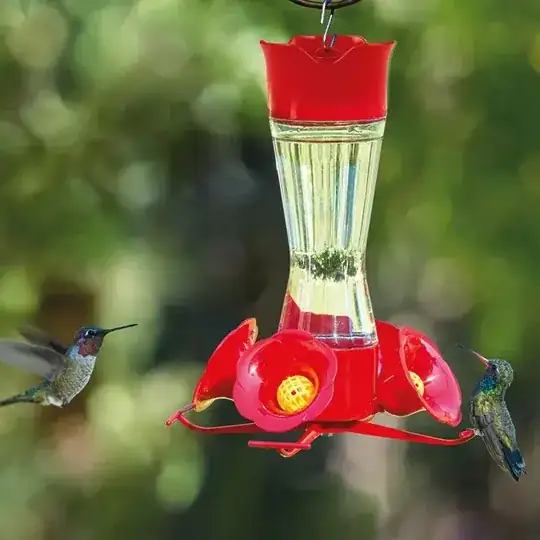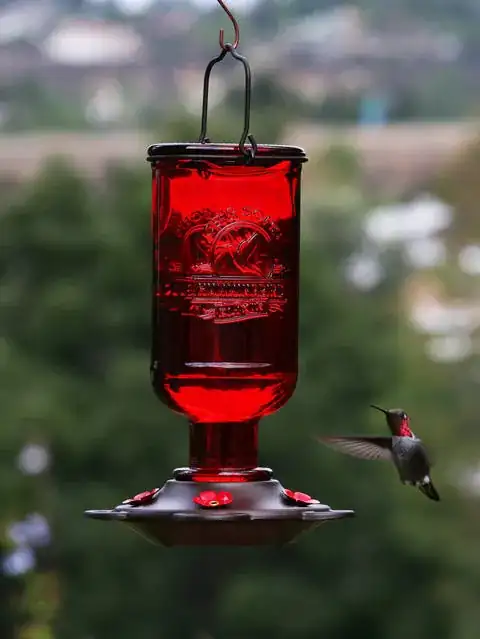Is there an effective way to keep bees and wasps out of hummingbird feeders? I have a problem where these stinging insects are preventing hummingbirds from feeding?
-
Check this site http://www.hummingbirds.net/feeders.html it has some useful information how to deal with insects. – False Identity Apr 03 '18 at 20:33
2 Answers
Technically, the bee-looking things you're seeing are a combination of wasps, honey bees, yellow-jackets, moths and a few other flyers. For the sake of ease in answering the question, I'll just call them all bees.
You didn't say whether or not you have a flower garden. If so, one of the best ways to keep the bees off the feeders is to plant flowers that attract bees. I noticed you live in Texas, and found a good list for you. We have a "bee garden" which is extremely effective. Large headed sunflowers keep the bees busy for months!
In addition to, or other than, flowers, there are a number of things you can do to keep bees off the feeders. I'll give you some ideas that have worked for us. None of our methods include anything that puts life in jeopardy, including the bees. It sounds like your question is looking for things along these lines.
Bees are attracted to yellow, and not red.
Many commercial hummingbird feeders have some yellow around or near the red part where the birds drink. We replaced all our feeders with yellow-free feeders, and have definitely noticed a difference.
Bees prefer sun to shade.
Put at least some of the hummingbird feeders in the shade. Doing this not only attracts more birds than bees, but also keeps the nectar solution clean longer. We have hummingbird feeders in both the sun and shade. There are always more birds on the shade feeders and bees on the sun feeders.
Change the nectar frequently, and clean the inside of the feeders every time.
Clean, fresh nectar is vital for birds, bees, and any other visitors. Bacteria grows very fast, especially if feeders are in the sun. Also, the ratio of sugar to water can separate as the liquid settles on its way to being empty. If the sugar settles to the base, bees are more likely to be attracted.
Keep the outside parts of the feeders clean.
When you fill the feeders, make sure no nectar drips down the side or onto any part of the outside of the feeder. Check all areas which you've touched. Little drops of nectar transferred from your hand to the outside of the feeder are enough to attract bees. Gently wipe any stray nectar off the feeder. Don't use any chemicals or spray cleaners. Those are fatal to anything that feeds there, including the birds as well as the bees.
Make sure the feeders aren't leaking.
Bees will quickly line up at any crack in the feeder where the nectar is either dripping out, or can be more easily reached. We learned that by accident. We found a feeder with bees bunched up in one section of the base of the feeder. We checked and there was a small leak in that spot. We let them finish, then replaced that feeder with a new one, and haven't seen more than one or two stray bees on that one at any given time.
- 6,215
- 8
- 39
- 74
-
1This sounds like great advice. I'd also add that the style of feeder matters. I had this issue with cheaper feeders where the "flowers" the birds fed from were very close to the nectar and the insects could get to it. The one I use now requires the birds to reach in with their long beaks to reach it. The insects don't really bother it and I think it's because they can't reach it. – Dalton Apr 04 '18 at 19:55
-
Thanks for supporting my answer! I didn't realize that about the shape of the feeders. It sounds important. It would be great if you would write an answer. It doesn't have to be long, but a description with a picture or link to one would help us learn about it. I myself want to try something like that. Thanks! – Sue Saddest Farewell TGO GL Apr 04 '18 at 20:06
so Sue had great answers. She asked me to post my suggestion with pictures. What I found made a difference was the shape of the feeding trough. When I was younger, my mother bought one that looked like this:

As you can see, the feeder holes are down near the very bottom. The bees proboscis was long enough to reach in and get some of the sugar water. Not to mention, it often leaked around those "flowers" so they could get it.
I happen to keep honey bees, so I know that a bee will go to a source of nectar till it dries up, until then it'll go there exclusively. Then when it finds another nectar source, it'll go to that one exclusively. It's called flower constancy. So like Sue suggested, if you have plenty of other sources available, then they shouldn't go after a source that either "A" is less sweet, because they always go to the strongest nectar source, or "B", they can't reach it, so it's "dried up".
When I wanted to start putting out feeders again a couple of years ago, I hadn't done it in years. I went an bought a new feeder, keeping in mind the issues we'd had with bees getting on them in the past. I found this feeder at Walmart.
The "flowers" are on top of the feeder and the level of the nectar is very shallow. You can see how far down the bottom of the feeder is. How it works is that the bottom is a shallow plastic bowl, with a tube in the middle. The inside of the tube is treaded and screws onto the glass. There are notched where the bottom of the tube meets the bowl. They're maybe 1/4" high. This works like those dog waters with 2-liter bottles. If a vacuum is present at the top of the feeder then the liquid only flows out till the level of liquid rises to the top of the notch and cuts off air flow. If air can't get into the container, then the vacuum is created and it hold the liquid in. This is basically how all feeders work, but since this bottom is deeper, the liquid stays shallow, and the holes are too small for anything but an ant to climb into. The birds can easily reach to the bottom. They often do so without landing, though my birds are lazy and would often land to eat.
So my thought is that a feeder that physically keeps the insects from getting to the nectar will control the issue, because no animal will die trying to get to a food source they can't reach if they have the option of moving on to one they can.
A last tidbit I found curious is the ratio difference in syrup between bees and hummingbirds. My mother always bought the jug of red hummingbird food. I found out with little research that it's just red dye and is at best neutral to the birds, but could potentially be harmful. Instead I just make my own. The difference is that while humming birds prefer a 1:4 solution of sugar to water, bees need a 1:1 or even 2:1 depending on the time of the year. You feed them if they run out of stores at the end of the winter or if you want to ramp them up prior to a nectar flow being available. I also know that they won't take sugar water if nectar is available, so it must be even sweeter. If there are flowers available, they should definitely go after them vs a weaker sugar solution. As a last interesting fact, in my journeyman's class, we had to study other bug life cycle. Some bugs change diets over the year. If I remember right, things like yellow jackets and wasps hunt more insects at the beginning of the summer to because they need the protein for laying eggs or growing. They need more sugar at the end of the summer, so that's why you'll see them getting in your soda cans. I might be remembering that backwards, but I still thought it was interesting.
- 5,092
- 1
- 21
- 37
-
Dalton, thanks so much for posting this! It's fascinating! That second feeder looks like the one we got after the leaking one I mentioned in my answer. We had much better success. It didn't occur to me why, until this explanation. Arrowkill, I hope this in-depth information and gorgeous pictures are helpful to you. – Sue Saddest Farewell TGO GL Apr 06 '18 at 22:04
-
They were! Not only did this answer my question, but I was able to educate the employees at the local hardware store to better help others with this problem (It is somewhat common in my area). – Arrowkill Apr 07 '18 at 15:32
-
-
@Dalton, I left a message for you in [chat]. This isn't really the proper way to notify you, but since I can't ping you from there, I didn't know what else to do. Once I know you've had a chance to see this, I'll delete it! Thanks! – Sue Saddest Farewell TGO GL Apr 09 '18 at 23:09
